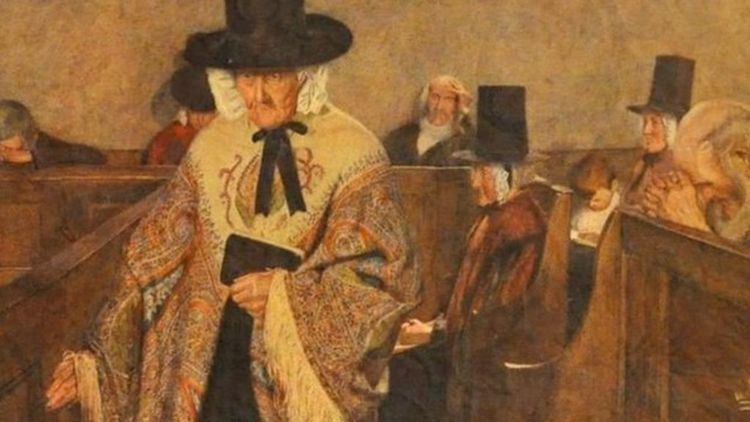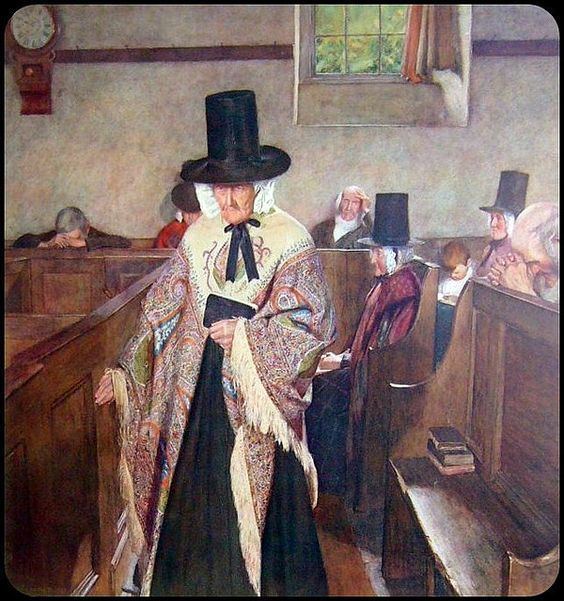Year 1908 | Created 1908 | |
 | ||
Dimensions 71.1 cm × 69.8 cm (28.0 in × 27.5 in) Location | ||
Interior of salem chapel near llanbedr gwynedd vosper painting wales
Salem is a 1908 painting by the English painter Sydney Curnow Vosper, depicting a scene within Capel Salem, a Baptist Chapel in Pentre Gwynfryn, North Wales. It is noteworthy as a depiction of Welsh piety, the traditional Welsh national costume, and for a contentious belief that the devil is depicted within it. Mass reproductions throughout the early and mid 20th century ensured the image became famous throughout Britain.
Contents
- Interior of salem chapel near llanbedr gwynedd vosper painting wales
- Capel salem
- History
- Composition
- Mass appeal
- Hidden figures and interpretations
- Exhibition
- References

The painting has been described as an icon of Wales, much as The Hay Wain is iconic of England.

Capel salem
History

Vosper had found success as a watercolour painter before coming to Wales; he had exhibited work in galleries throughout England, and at the Paris Salon and the Royal Academy in London. He was noted for his paintings of people, particularly the people of Le Faouët in Brittany. Vosper's Welsh paintings began with his marriage to Constance James of Merthyr Tydfil in 1902, and ended after her death in 1910.
Vosper first saw the chapel in 1906, not long after the "Welsh Revival". He had already painted many famous images of prayer and piety in Brittany, and it would seem the chapel and its congregation inspired him in much the same way.
Composition
Only one of the figures was actually a member of the chapel, Robert Williams of Caer Meddyg, a carpenter, farmer and deacon at Capel Salem, he can be seen on the far left beneath the clock. Next to him, and slightly obscured is Laura Williams of Ty'n-y-Buarth, Llanfair. Left of her, with his back against the wall is Owen Jones (commonly called Owen Siôn) of Carleg Coch. The small boy is Evan Edward Lloyd and by his side is Mary Rowland. On the extreme right with his head bowed, is William Jones (William Siôn), brother of Owen. Vosper paid each model 6d. (2.5p) an hour for sitting.
The main figure is Siân Owen (born in Maesygarnedd in 1837), at the time of painting she was 71 and lived in Ty'n y Fanog on the backroads from Llanbedr. She was a widow having lost her husband George in the 1880s. They had one son (William) and Siân raised both William's sons in her tiny cottage, sadly both her grandsons would be killed in the First World War. Siân Owen herself lived on until 1927, and is buried in Llanfair churchyard, Harlech.
The eighth figure (second right of Siân Owen, wearing a Welsh hat) was actually a borrowed tailor’s dummy which Vosper named "Leusa Jones". The chapel elders, uncomfortable with the dummy in a place of worship, insisted the dummy was to be removed each Saturday night before the "seiat" (weekly church meeting) the following morning.
Why Vosper chose Siân as the main figure is unclear, though there is a Welsh cultural image of a strong maternal figure considered iconic to 19th century Welsh family life (Mam Cymru). Siân Owen would have had to stand for days wearing the shawl so that Vosper could paint its intricate detail and folds, Vosper later complained that she twitched and moved so much that it became very difficult to accurately reproduce the pattern and colour of the shawl and he eventually gave up, pinning the shawl to the dummy for the final stages. Despite this difficulty, he would again work with Siân Owen in Market Day in Old Wales (1908).
The Welsh hat was a fashion which was current in the 1830s and 1840s. By the time of painting the hats were no longer worn by women in Wales, and the wearing of hats inside a chapel would have been considered a faux pas, especially for women. Vosper, however, wanted the women to wear traditional tall stove pipe hats but could find only one remaining hat in the area. Vosper had the hat shared amongst the models, painting the same hat into the composition four times. Siân Owen's ostentatious shawl was likewise uncommon and was borrowed from the wife of the vicar of Harlech.
Mass appeal
Vosper exhibited ‘Salem’ in 1909 at the Royal Academy in London where it came to the attention of the industrialist William Hesketh Lever. Lever bought the painting for £105 and the original can be seen today in the art gallery he established at Port Sunlight. The painting may have remained obscure in his private collection had Lever not decided to use the painting in a promotion of the Lever Brothers' popular product Sunlight soap.
The soap bars came with collectable tokens, and buying seven pounds of soap would acquire enough tokens to exchange for a print of the painting (an early example of marketing premiums). This promotion resulted in Salem appearing in many homes across Britain. At that time many homes owned no form of visual art and the innovative 'free gift' offer ensured prints of Salem became widely, and uniquely popular amongst working class communities, especially in Wales.
By 1933 the painting was famous enough to be the subject of a notable article in the Welsh language magazine Y Ford Gron (The Round Table) and by 1937, Salem gained yet more popularity when Sir Ifan ab Owen Edwards sold thousands of prints to supporters of the Urdd Gobaith Cymru for 6d. By 1942 it was described by Yr Aelwyd as "One of the most beautiful pictures of the religious life of Wales in old times" and in 1950, 1956 and 1957 many more Welsh households obtained copies when the picture was used in the Cymru Fydd calendar. By the 1960s, the painting was famous throughout Wales and was ubiquitous in many Welsh communities. Today a framed print of Salem hanging on the wall is a feature of many Welsh museums and historical buildings.
Hidden figures and interpretations
As reproductions became popular, so did the notion that it contained a hidden figure. Discussions of the painting's intended meaning often used this notion to support their interpretations.
Aside from pious interpretations, there was much speculation that the painting had a more disapproving meaning. Some suggested the painting was a comment on the sin of vanity. The Chapel clock suggests Siân Owen is arriving belatedly at a few minutes after ten (during the traditional Welsh silence before the morning service), possibly to ensure her presence is noted and appears to be wearing comparatively ostentatious clothing. The interpretation was often synonymous with a popular belief that Vosper had hidden an image of the devil in the folds of Siân Owen's shawl. The postulated image can be seen in the section of shawl around her left arm. The paisley pattern forms a horn, the folds his eye and nose and the shawl's trim his beard.
When questioned on this, Vosper always denied any such detail had been intentionally painted into the shawl. The enigmatic painter did confirm, however, an intended ghostly face painted into the verdant window scene. The partial knowledge of a hidden face somewhere within the painting is a likely starting point for the popular theory of a devil within the shawl.
The painting's variable interpretations (especially as an admonishing lesson on pride) are now considered valuable example of how the Welsh viewed themselves, and their rural nonconformist past in the twentieth century. The devil in the shawl is now most commonly considered an example of pareidolia.
Exhibition
The work is presently exhibited at the Lady Lever Art Gallery at Port Sunlight, though there have been several attempts to permanently house the painting within Wales, most notably by a campaign in 2005 headed by Plaid Cymru's culture spokesman Owen John Thomas. In 2013 it formed the centrepiece of a temporary exhibition at the Gwynedd Museum and Art Gallery in Bangor.
Many Welsh museums and galleries hold and exhibit Vosper paintings from the same period. Most notably the National Museum Cardiff houses Market Day in Old Wales (1908), a later Vosper painting featuring Siân Owen. Often considered a sister work, the painting was gifted to the museum by Constance Vosper’s brother, Frank Treharne James in 1914. Speaking in 2005 on the possibility of acquiring Salem, the Museum's director said "It was commissioned by the Lever family therefore belongs in the gallery they created, now belonging to the National Museums Liverpool".
Hel Staeon a 1988 S4C arts programme revealed the existence of a slightly different version of Salem, owned by a descendant of Frank Treharne James. Peter Lord. An authority on Welsh painting, verified this second work as a Vosper composition. This painting is on display at Cyfarthfa Castle in Merthyr Tydfil, along with many other Vosper works bequeathed to the town upon the death of his second son.
